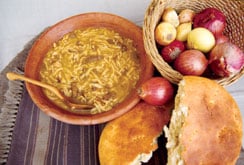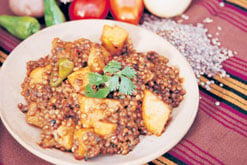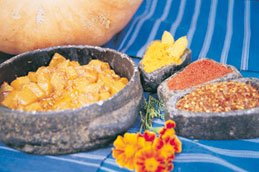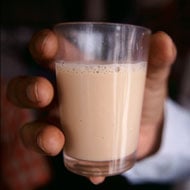
RECIPES
The selections that follow have been chosen for ease of preparation in a western kitchen and for their adaptability to non-Hunza palates. Because the women of Hunza cook from heart and habit, measuring cups and scales don’t exist in their kitchens, so use these guides casually. Unless otherwise specified, the recipes are for three to four people. Be creative, adapt, substitute—and enjoy the result!
Appetizers
Baloganze Pitchu
Here is an easy tomato dip that can be eaten warm or cold, as a snack or as part of a meal.
| 3–4 small tomatoes 1 large onion 1 small green fresh chile pepper 3 spring onions 3–4 garlic cloves 1 strand fresh coriander 1 tsp salt 20 ml (1½ Tbs) cooking oil 250 ml (1 cup) water |
 |
Chop the onion and the tomatoes into medium sized chunks. Cut the chile pepper in half, remove seeds and chop very fine. The spring onions, garlic and coriander leaves should also be chopped very fine. Mix the chopped tomatoes with the spring onions, garlic and coriander and salt in a bowl and set aside.
In an iron pan, heat the oil and fry the onion until transparent and starting to brown. Add the water and then the tomato mixture and simmer on low heat for at least 10 minutes. Add a few minutes cooking time if the sauce is too liquid or add more water if too thick.
Decorate with a few fresh coriander leaves. Eat with chappati (or any other flat bread).
Burutz Berikutz
Burutz is similar to a fresh cream cheese or cottage cheese, and this cheese chappati is not unlike a Mexican quesadilla.
| 250 gr (9 oz) burutz 2 spring onions 50 gr (≈2 oz) fresh coriander leaves 50 gr (≈2 oz) carrot greens or dill 50 gr (≈2 oz) mint leaves salt to taste 100 ml (≈½ cup) lassi (optional) apricot oil 8 chappatis |
 |
Make eight chappatis according to the basic chappati recipe (see page 40) and set aside.
To make the cheese filling, chop the onions and herbs very fine and mix together in a bowl. (Other herbs and spices could be used.) Add the burutz and salt and mix well. To get a more spreadable filling, mix in some lassi or yogurt.
Spread four chappatis with ¼ of the cheese mix each and cover with a second chappati on top. Generously brush top with apricot oil. Cut in slices for serving.
Soup
Chapsae Doudo
This meat soup is simple mountain fare that can be adapted to nearly any type of meat—and it takes care of old bread.
30 ml (2 Tbs) cooking oil |
 |
In a saucepan, heat the oil and fry the chopped onions until they become transparent and start to brown. Add a pinch of turmeric. Cut the meat in small chunks and add it to the onions. Continue frying for about 5 minutes, stirring frequently until the meat is well browned.
Add salt and water and bring to a boil. Lower heat, cover and simmer for about 15 minutes until the meat is well cooked. Add sliced chappatis and cook for a few more minutes.
Main Courses
Girgir Aloo
This brown lentil and potato dish will taste familiar to western palates.
300 gr (1½ cups) |
 |
Cook the lentils in a pressure cooker in 250 ml (≈1 cup) of water for 20 minutes, or for 1 hour in a regular saucepan or pot. Drain them and set aside.
Fry the chopped onions in oil until slightly brown. Then add the chopped tomatoes, chopped coriander leaves, chile powder and turmeric. Cover with 250 ml (≈1 cup) of water and bring to boil. Boil for 5 minutes, then mix in the salt, fresh chiles (whole) and potato chunks. Cover and stir occasionally.
Finally, add the cooked lentils and more water if necessary. The vegetables should be barely covered. Boil over medium heat for 15 to 20 minutes until potatoes are soft. Serve with chappatis.
Hosarye Hoi
This is pumpkin curry stew, which is eaten in Hunza with chappatis, but elsewhere it adapts gracefully to the accompaniment of other flatbreads or even rice.
1 kg (35 oz) fresh pumpkin |
 |
Cut the pumpkin in half and take out the seeds before you cut it into bite size chunks. Leave the skin on. Heat the oil in a frying pan, add the chopped onions and cook until transparent. Then add tomatoes and spices and fry on high heat for 5 minutes.
Stir in the pumpkin chunks and the salt. Pour water over the vegetables and cook over low heat, covered, for approximately 10 minutes or until the pumpkin is soft.
Chap Shuro
Hunza meat cakes are fun to make with children, and if you don’t have time to make the dough, you can use a ready-made pizza crust.
For the dough: For the filling: |
 |
Mix flour with salt and water to make a solid dough. Divide it into four pieces and roll out each piece into a flat round about 20 cm (8") in diameter.
For the filling, chop the chile peppers, onions, spring onions, tomato and fresh coriander leaves quite fine, then mix with the ground meat and salt in a bowl.
Take one round of dough and wet the rim with some water. (Use your finger.) Spread half of the meat mixture on the dough, leaving a space of 1 cm (⅓") around the edge, and top with a second round of dough. Press down the edges and fold over a small rim to seal. Repeat.
Bake on medium heat on both sides for 15 minutes each, until golden brown.
Breads
Burum Hanik
Chappati and butter—especially the precious maltash—is one of Hunza’s strongest symbols of hospitality, and it is usually served at the beginning of an event, whether there will be more food or not. It is best cooked using the open flame of a gas stove.
500 gr (4 cups) flour |
 |
In a large bowl, mix the flour with about two-thirds of the water and start kneading the dough. Slowly add more water until the dough gets firmer and doesn’t stick to the bowl anymore. Knead for at least 10 minutes. Chappati dough should be soft but not sticky. Add more flour if necessary.
Divide the dough into eight even pieces and roll into balls. Sprinkle some flour on a wooden board and roll out each piece with a rolling pin, flipping, rotating and sprin-kling the dough with flour to get an evenly round chappati that won’t stick to the rolling pin. Each chappati should be about 20 to 25 cm (8–10") in diameter and as thin as your skills allow.
Place the chappati on a heated griddle or iron pan (no oil!) and brown on each side for not more than one minute. Arrange the chappatis on a plate and place some butter in the middle while they’re hot. Makes eight chappatis.
Shuro
This is a festive white bread.
250 gr (2 cups) flour |
 |
Place the flour and the baking powder in a large bowl. Mix in the butter and eggs. Add the salt and milk, and knead until a firm dough forms. Let rest in a warm place for 30 minutes.
Roll the dough out in a round shape. Use a fork to make a nice pattern on the top. Cook on a hot pan or griddle for 1 minute. Finally place the bread in a preheated 250° C (475° F) oven for 20 to 30 minutes. When the shuro begins to turn golden brown, it is done.
Qista
Even though this Hunza chappati uses self-rising flour, it is actually a yeast bread. In the past, women used a sourdough method, keeping dough near the fire for a long time until natural fermentation produced the desired amount of leavening.
Ingredients for |
 |
Knead the ingredients into a firm dough. Cover the dough with a moist cloth and let it rest for 30 minutes in a warm place. Divide the dough into two balls and roll out each piece with a rolling pin until it
is about 7 mm (⅓") thick. Cook on a flat iron pan or griddle on both sides until golden brown.
Maltashtze Giyaling
These Hunza pancakes are the traditional dish prepared when a daughter visits her parents’ home after her marriage. It is eaten with chai (tea). Try it for breakfast.
200 gr (1⅔ cup) sifted white flour |
 |
In a bowl, whisk the flour briskly into the water and oil. Add the egg and mix well. Let the mixture sit.
Heat a griddle or crêpe pan and spread with some oil. When the oil starts smoking, pour a generous spoonful of the mixture into the center of the pan and spread it out to a crêpe of about 20 cm (8") in diameter.
When the pancake starts bubbling, flip it over, lower the heat and cook for another one to two minutes. Spread each layer with melted butter and stack.
Dessert
Sultan Qoq
This healthy fruit-and-nut bar also makes good carry-along food. It can be adapted to other dried fruits depending on availability and taste. If it’s not sweet enough, add a bit of brown sugar.
200 gr (1½ cup) apricot kernels or almonds |
 |
In a coffee grinder or mortar, finely grind the apricot kernels and walnuts and set aside. Then grind the dried mulberries. Mix the ground nuts and the fruits, and add water to make a thick paste. This can either be done in a blender or by hand in a bowl. Roll the paste into a ball and shape it any way you like.
Drinks
Chhamus
This is a handmade apricot juice.
200 gr (1½ cups) dried apricots
1 liter (4 cups + 3 fl oz) water or less, depending on desired thickness
Soak the dried apricots in hot water for about one hour. Traditionally, this juice is literally kneaded by hand for hours until the apricots become soft and finally mix com-pletely with the water. For an easier and much less labor-intensive solution, simply mix the soaked apricots with water in a blender. You can also use fresh apricots with less water.
Tumuro Chai
An interesting tea for westerners, most of whom don’t think of thyme as a herb used in tea. In Hunza, it
is valued for its medicinal properties: It is said to alleviate headaches, calm nerves and soothe sore throats.
4 tsp dried wild thyme
500 ml (≈2 cups) water
Add the thyme to the water in a pot and bring to a boil. Let the tea boil for a few minutes to extract the flavor from the leaves. Strain before serving.
Balingi Chai
Or try walnut tea.
8 walnuts, shelled |
 |
Crush the walnuts in a mortar or process in a blender. Mix with the black tea and add to the water in a pot. Bring to a boil. Once the water is boiling, add the milk. When the milk starts to rise, take the tea off the heat. Serve with sugar or honey.